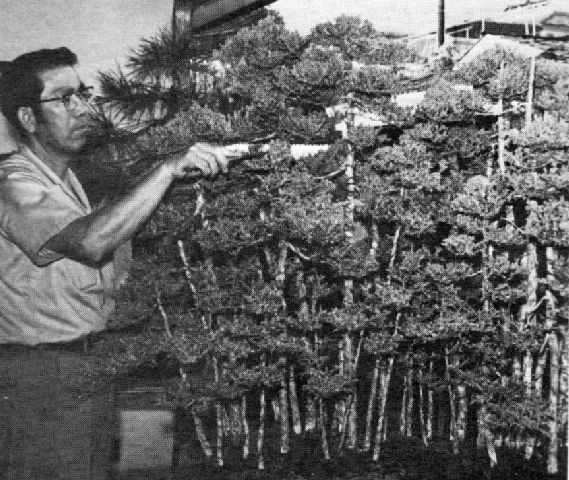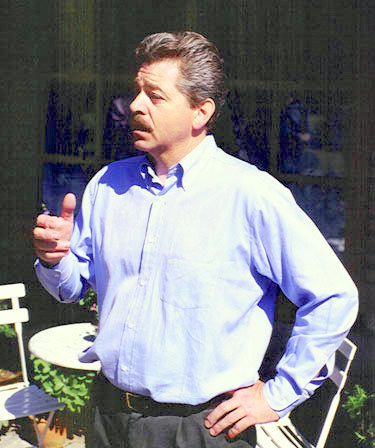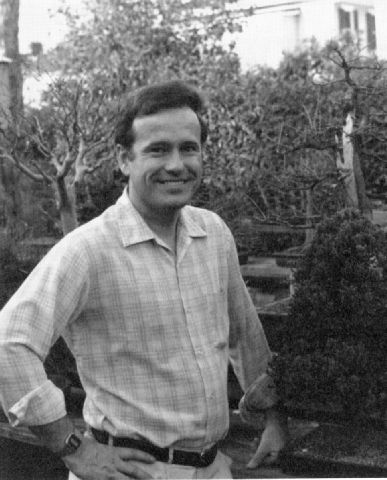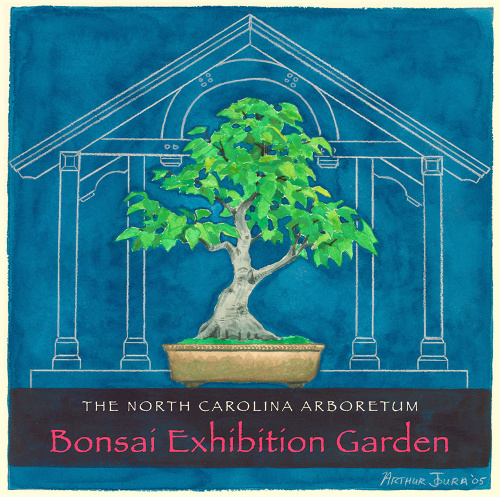| 1 |
1969 -- Japan issued a set of four postage stamps commemorating the 16th UPU Congress, which was held in
Tokyo. The four ukiyo-e images included Harunobu's "Two Women Reading
a Letter." That print, from before 1770, has a depiction of a deep-potted bonsai in the upper
right-hand corner.
SEE ALSO: Jan 23, Jan 29, Feb 3, Feb 16, Mar 1, Mar 27, Mar 31, Apr 3, Apr 6, Apr 18, May 6, May 29, Jun
16, Jul 20, Aug 20, Aug 22, Sep 22, Oct 4, Dec 9.
1990 -- The John Y. Naka Pavilion and the National Collection Of North American Bonsai (which would be housed therein) were dedicated at The U.S. National Arboretum in Washington, D.C. Some 1,000 people representing bonsai organizations throughout the U.S. and Japan gathered with officials of the U.S. Dept. of Agriculture for the milestone event. The initial collection was composed of 56 bonsai -- out of over 100 nominated specimens -- of various artistic philosophies representing 50 individual donors from 15 states and 38 species in diverse styles and containers. (Naka, John Bonsai Techniques, pg. 261; International Bonsai, IBA, 1990/No. 4, pp. 20-23 ) SEE ALSO: Mar 20, May 2, May 17, Jun 9, Aug 16, Aug 26, Sep 30, Oct 10, Oct 15, Nov 5 2009 -- Lindsay Farr's WorldofBonsai, Series 2 debuted. [Future episodes would be put on-line every week in October. The first 5 episodes celebrate the world's most sustainable bonsai community which is on the island of Shikoku in Japan.] SEE ALSO: Mar 4, Jun 1, Aug 9 |
| 2 | 1975 -- A four-day bonsai show, under Royal Patronage, opened by the Royal Horticultural Society of Thailand in Bangkok. ("Bonsai Show Calendar," Bonsai Magazine, BCI, October 1975, Vol. XIV, No. 8, pg. 262) |
| 3 |
1925 -- A person who would be known to us as Marybel Balendonck was born in Dallas,
TX today. [She would go on in a long life to be a student, artist, and founder and major
influence for what would be the National Bonsai Foundation.]
("Marybel
Balendonck Obituary," The Orange County Register) SEE ALSO: Feb 28
1970 -- A prize-winning "Forty-seven Ronin Forest" was displayed at the two-day Akebono Bonsai Society of Southern California Exhibition which started today at the Los Angeles Arboretum. Ben T. Suzuki, instructor for bonsai courses at Los Angeles City Colege, Pasadena City College, and at the County Arboretum in Arcadia each week, created the composition with 47 junipers in a container 25"wide x 49"long x 3"deep. The name of the large yose-ue is taken from the famous Japanese legend about the Forty-seven masterless saumrai who avenged the death of their master. (See Note 8.) The piece belonged to Mrs. Patricia Nixon, the First Lady, and in Japanese tradition, was cared for by Suzuki. Mrs. Nixon was not able to attend the display. 
|
| 4 | 1981 -- " Dwarfed trees," a set of four postage stamps, was issued by Thailand to celebrate that country's native styles. SEE ALSO: Jan 23, Jan 29, Feb 3, Feb 16, Mar 1, Mar 27, Mar 31, Apr 3, Apr 6, Apr 18, May 6, May 29, Jun 16, Jul 20, Aug 20, Aug 22, Sep 22, Oct 1, Dec 9. |
| 5 |
1952 -- Pius Notter was born in Switzerland. [Born into a farming family of eight
in rural Switzerland, to help his factory worker father Pius would begin his post-school working life as a village
baker's apprentice. He would work 65 hours per week, getting up every day at 4 in the morning. But he
soon would see this was not his path in life; for one thing, the flour dust would make him ill by age 24.
Circumstances would lead him to the life insurance business where he would meet with considerable success from the
start. Pius would rise briskly through the ranks as a manager. But his heart would lay elsewhere, in the
clean beauty of the mountains where he'd go to switch off from professional pressures and recharge his energy.
He would collect stones and crystals and even plants and small trees. And then his mother would give him a
copy of an all-round garden book by Reader's Digest (originally pub. 1978). In it would be a small section
about the art of the Japanese garden, in particular, bonsai. He wouldn't look back. His hobby would
became his work and his joy would be self-evident. Because he would be one of the first to promote work with
yamadori, he'd be rightly among the growers who'd have really influenced the European bonsai and would
co-create a new direction for bonsai growing on that continent. He would not be copying Japanese patterns, but
would use the shapes already created by the harsh climatic conditions of the surrounding mountain areas. [In 1980 he would co-found the Swiss Bonsai Club (SBC) with employees of the local tree nursery and three years later would become its president. He would publish the first articles in the German Bonsai Club magazine and in 1984 he'd publish the first of nine books, at least half of which would be multi-lingual. In the spring of 1985 he'd take a leap of faith and quit the insurance and finance business that had been very profitable for him. Negotiating a deal with the director of the tree nursery to keep his wage losses within limits, Pius would take over the position of business manager of the Bonsai Center in Schinznach-dorf. The following year, Boswil, Lucerne, Switzerland -- where Pius would be living about 40 km away -- would open its own arboretum and bonsai garden. Pius would receive an award from the Japanese Bonsai Association (Nippon Bonsai Association) in 1988. The year 1989 would mark the start of regular bonsai-shaping seminars, which, again, would have a significant impact on European bonsai. Pius would also owe his talent to art: he would draw very well with charcoal pencils. He'd often supplement some of his many publications and use the sketches extensively in public demonstrations of shaping. While in the 1980s Pius would focus on the development of bonsai in Switzerland, the 1990s would mark the intensive development of contacts with the world, and especially with Japan. Pius would be invited to a variety of bonsai exhibitions around the world. Another, perhaps even more important contribution of his frequent travel and intense business contacts would be the visit of personalities such as Masahiko Kimura, Kunio Kobayashi, John Naka, and others who'd give their art to several lucky Europeans at workshops and demonstrations. Pius would be the first European to be invited to the 2nd World Bonsai Congress as a demonstrator (1993, Florida, USA), plus be in the 3rd in Korea in 1997. He would be in the First Latin American Bonsai Encounter in San Juan, Puerto Rico in 1994, the 1995 European Bonsai Association meeting in Monaco and the next year's in Germany, the 3rd Asia-Pacific Bonsai Suiseki Exhibition and Convention in Singapore in 1995 and the 7th ASPAC in Manila, Philippines in 2003, and the BCI Conventions in Washington, DC in 1996, the Bahamas in 2001, and Rochester, NY in 2003. (RJB would very briefly meet Pius in California in March 1997 at the opening of the GSBF South collection at the Huntington Museum.) From the European point of view, a new and greatly important magazine on bonsai, Natur und Mensch, would be first published by Pius in 1997. The publication would include interesting reports from around the world, introduction of famous and new personalities of world bonsai, trees from nature, photos of ancient bonsai. In the year 2000, Pius would win the JAL World-Bonsai-Contest with a 120-centimetre-high bonsai that he'd have grown from a 400-year-old mountain pine which had been damaged in a rockslide. Because of his workload, his friend Georg Reinhard would then take over publication of Natur und Mensch, whose title would be changed by 2011 to bonsaikunst. As a guest in the most beautiful gardens in the world, Pius would become recognized around the globe as a master of garden architecture. His own garden design company, Natural Art Services, would be founded in 2004 to create and then care for three-dimensional horticultural status symbols that provide nourishment for the soul for many of the richest Swiss persons and companies. In 2008 he would acquire a digital camera and start photographing birds around the world as a hobby.] 
Pius Notter, 06/12/04
("Pius Notter," aubonsaiwiki;
Sosnovec, Cestmír "Pius Notter,"
Bonsai Sumiko, 17 Aug 2004, Google Translate 11 Feb 2018;
"Pius Notter, garden
architect," video; Morgenthaler, Mathias
"Wie
ein gelernter Bäcker-Konditor zu Daniel Vasellas Gärtner wurde," 24 March 2011 interview, translated with
IMtraanslator;
"Swiss wins Japanese Bonsai competition,"
swissinfo.ch, December 1, 2000) SEE ALSO: Feb 28, May 25
(Photo courtesy of Alan Walker, 05/11/07) 1986 -- The six day long Chinese Penjing Theory Symposium and Regional Styles of Chinese Penjing Exhibition began at the same time in Wuhan, Hubei Province, in the Peoples Republic of China. The display included 273 penjing (trees and landscapes), mostly of medium- and small-size specimens. In attendance were 182 representatives of 24 provinces and autonomous regions, including the three municipalities Beijing, Tianjin and Shanghai. Altogether, 48 cities were represented. The symposium was divided into two main parts: lectures and demonstrations, and theory discussions. Topics included the standards for "Penjing evaluation," "Penjing as an art - the historical heritage and the future" and "Penjing production for commercial purposes." (International Bonsai, IBA, 1987/No. 2, pg. 17) |
| 6 | 1982 -- K.C. Jay died. Mr. Jay, a Hong Kong bank consultant and financier, was the founder and president of Hong Kong Bonsai International, the organization which regularly staged an annual bonsai exhibit in March at the Urban Council Center. (ABStracts, ABS, Vol. 11, No. 1, February 1983, pg. 2 ) |
| 7 |
1989 --
The Pacific Rim Bonsai Collection
was dedicated in Federal Way, Washington on the campus of the Weyerhaeuser Corporate Headquarters to celebrate
the Washington State Centennial and to honor the company's trading partners in the Pacific Rim nations.
David DeGroot was named curator for the collection of over sixty trees.
David DeGroot
("Pacific Rim Bonsai Collection Opens" by David DeGroot, Bonsai Magazine, BCI, Nov/Dec 1989, pg.
19) SEE ALSO: Jan 26, Mar 8, Apr 2, Dec Also
(Bonsai Journal, ABS, Spring 1989, pg. 17) |
| 8 |
2000 -- The first symposium of the newly-formed Association of British Bonsai Artists (ABBA) was held at Failand
Village Hall, Bristol. Staged by the members of the
Association with nonmembers being able to attend by pre-booking, the theme was "Scots pine and its cultivars."
Members' and guests' trees were displayed around the hall and a critique was held for each tree. The
afternoon session started with a lecture/demonstration by Nobuyuki Kajiwara on the art of presentation in the
tokonoma. A question and answer period followed, and the final part of the day was an open forum.
(ABBA web site, "First Symposium & Exhibition,"
http://www.bonsaiartists.co.uk/Articles.aspx?theme=archive&article=42)
SEE ALSO: Mar 19, Sep 1
2005 -- The North Carolina Arboretum's Bonsai Exhibition Garden opened to the public after a three-year design process. This is a sloping landscape of low shrubs that follows a dry stream bed over bridges and down serpentine paths past a selection of the Arboretum's collections. Here are more than 100 display-quality specimens in the botanically diverse bonsai collection, and several hundred more are in various stages of development. All of these plants have been either donated by private individuals or created at the Arboretum from seedlings, cuttings, nursery culls or plants collected from the landscape. (In 1992, the Arboretum, an inter-institutional facility of the University of North Carolina, serendipitously received a donation of a large number of bonsai and containers from George and Cora Staples of Butner, NC. The Stapleses were ailing when they finally decided they could no longer care for their collection. The plants were ailing, too. Many were culled because they were too far gone. Others required a great deal of nursing and years of care to get back in good health. Staff member Arthur Joura was assigned responsibility for the care and development of the bonsai collection and an attendant program to support it. Other donations to the bonsai collection followed as longtime enthusiasts in the region recognized the value of the Arboretum's involvement, and contributed prized specimens from their personal collections. Sustained public support has been a key ingredient in the success of this dynamic bonsai assemblage which Joura, the bonsai curator, has built into one of that institution's strongest components. Additionally, Joura has introduced to bonsai culture over 50 species native to western North Carolina and created several tray landscapes depicting well-known regional sites.) 
|
| 9 | 1999 -- Rolf A. Stein died in Paris. (He was born in Berlin where he did part of his Oriental studies. Going into exile in Paris in 1933, six years later Professor Stein joined the prestigious École Française d'Extrême-Orient. His early field studies were done in Vietnam and China. In 1943 he published his first book, Jardins en miniature d'Extrême-Orient, a sophisticated exploration of a complex subject, full of brilliant insights. Later on he taught at the prestigious French institute Collège de France and it was during his tenure there (1966-1982) that he published successively three prominent books in relations to the Tibetan culture. Up until 1992 Stein continued to participate in the academic works, and in collaboration with other prominent Orientalists he authored books on Buddhism, Tantra and Mythology. In 1987 Jardins was republished in its original French along with a 1958 work about "Dwelling Places [of the Spirits], Their Physical Details." Three years later an English translation of those two was published with a new third study, "The World and Architecture in Religious Thought," as The World in Miniature: Container Gardens and Dwellings in Far Eastern Religious Thought. This awesome work brings into sharp focus myriad subtle mutations of the miniature garden which -- reflected in the temples of Heaven, pagodas, the felt tents of nomads, and ultimately the human body itself -- informs cosmology, ritual, ethics, aesthetics, and many aspects of everyday life. Symbolism and history of dwarf potted landscapes unknown anywhere else can be found here. Yes, we do deal with magical miniature landscapes.) ("Cover," Bonsai Magazine, BCI, September 1970, Vol. IX, No. 7, pp. 2, 15) ["Rolf Stein Passed Away in Paris," World Tibet Network News, Friday, October 15, 1999, http://www.tibet.ca/en/newsroom/wtn/archive/old?y=1999&m=10&p=15_6; Foreword by Edward H. Schafer in The World in Miniature (Stanford, CA: Stanford University Press, 1990), pp. xviii-xix] |
| 10 |
1964 -- The 16-day "greatest cooperative exhibition ever presented in the history of
bonsai" and suiseki opened in Hibiya Park to commemorate the Olympic Festival in Tokyo.
The organizers had sought something with a Japanese theme to which outsiders could relate,
and these two arts -- characteristic expressions of Japaneseness -- were selected as the
only officially sanctioned artistic event connected with the festivities. This exhibit was
the Nippon Bonsai Association's first official act. In addition to that Association, sponsors
included the Tokyo Metropolitan Government, the Tokyo Olympic Organizing Committee, the
Ministry of Education, and the Ministry of Foreign Affairs. Some of the most
important organizations in Tokyo also provided backing, both financial and political. There were
283 bonsai and 90 suiseki on display. The list of exhibitors read as a "who's who" of the
Japanese elite and the leading bonsai artists also read like an all-star cast. The
vast majority of the exhibitors were from Metropolitan Tokyo and the neighboring Chiba and
Saitama prefectures, because these areas had recovered from the devastation of war first and had begun
to prosper in the new economy. [The shows would draw large and enthusiastic crowds and be
granted major coverage in the local media. It also would draw a large number of overseas visitors
attending the games and generate the sought-after international publicity. This exhibition would
result in a new bonsai market emerging that supported nurseries and artists. The new patrons would
attend workshops, lectures, demonstrations, and shows, and would purchase potential raw material as well
as supplies and tools. Several monthly magazines would then be devoted to bonsai, satsuki and
suiseki, and publishers would prosper by printing an abundance of bonsai books. Clubs, both large
national ones and smaller local ones, would be organized after this exhibit. Early international
interest would dramatically grow as what some pictured as a quaint Oriental curiosity would transform itself
into a hobby and acknowledged artform practiced by thousands upon thousands on every continent.
The exhibit would last one day longer than the Games of the 18th Olympiad, which saw 5140 athletes from
93 countries competing in 163 events in 19 sports. "Mondovision" would allow some 600 million to view
the games on television, and an American satellite would give 23 European countries the opportunity to follow the
events. The people of Japan would show their enthusiasm by attending the Games en masse. Almost
two million tickets would be sold and, overall, the Games would be a huge success also.]
(Aradi, Peter "Gems of Bonsai & Suiseki at the 1964 Tokyo Olympic Games,"
International Bonsai, IBA, 2003/No. 1, pp. 18-21; "Bonsai -- Olympic Show," Japanese/English booklet,
8 pp. w/9 b&w photos; "XVIII (18th) Olympiad,"
http://www.kiat.net/olympics/history/18tokyo.html)
SEE ALSO: Sep 1
1984 -- The five-day long First International South African Bonsai Convention opened in Johannesburg. The headliners were John Naka and Shigeo Katō. (Bonsai Magazine, BCI, Jan/Feb 1984, pg. 10) |